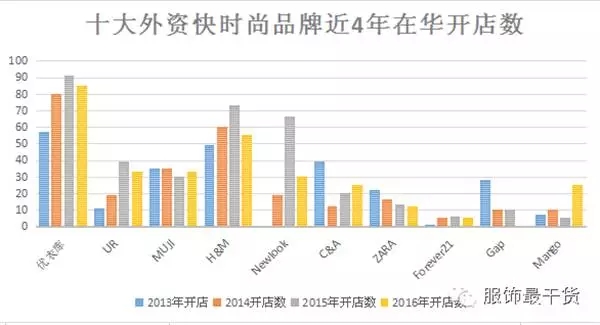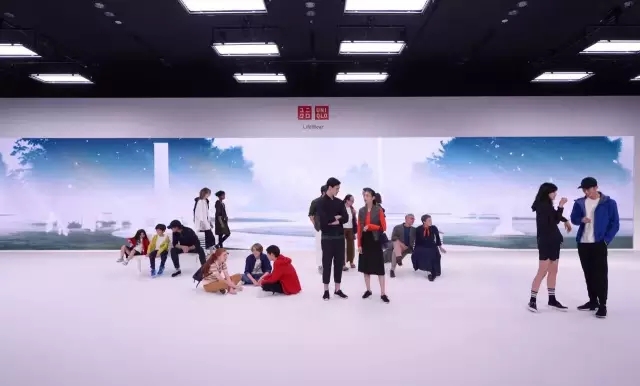How do you get better UNIQLO's business in the face of adversity?
For the upcoming 2016, some people call it the “failure†year of fast fashion: the fast-fashion brand that has been triumphantly rushing has experienced a slowdown in the opening of the store and a decline in profits. In October this year, the report of the 2016 fiscal year (September 2015 to August 2016) released by the UNIQLO parent company Fast Retailing Group showed that although the Group's total revenue increased by 6.2% over the previous year, its operating profit decreased by 22.6%. The situation of other fast fashion brands is similar.
With the release of the latest data, we are concerned about these two figures: First, Uniqlo broke through 500 stores in China, which became the fastest fashion brand with the largest number of stores in China; Second, the same store sales of Uniqlo in Japan increased by 7.3%. A long stretch of strength.
The standard for measuring success is not at the height of the standing peak, but at the rebounding force that falls into the trough. This is true for one person, and for businesses. The author believes that Uniqlo is a good research sample when the current physical store is facing adjustment. It tells us how to do business in adversity?
After visiting the UNIQLO denim fabric supplier and communicating with many UNIQLO headquarters executives, the author has two judgments: First, although the current apparel retail industry is facing challenges, if Uniqlo strengthens its current product strategy and market strategy, the future may Ushering in a rebound in performance; Second, the SPA retail model represented by Uniqlo will have a bigger role in China's third- and fourth-tier cities.

Data source: Lianshang
Make a big opening
All categories, full scenes, all ages
At the LifeWearday scene at Uniqlo in Tokyo on November 18th, a novel catwalk made a splash. Not in the traditional fashion show, tall models wear grotesque fashion dresses on catwalks, but models play a common sight in life: on the way to work, in the office, on the beach, on a walk in the park, or even One afternoon after the rainstorm is coming... There are young men, women, children and even middle-aged people in the model. The clothes they wear are the new 2017 clothing that Uniqlo will be listed soon.
The audience’s shared feelings about this show are: living, grounding. The author believes that this catwalk is in line with Uniqlo's product development principles: focusing on the basics needed for daily life, making all-product products, covering the entire age group, and getting involved in the whole scene of life, connecting daily life with fashion taste. Or you can understand that Uniqlo does not sell clothes, but outputs a stylish clothing matching solution.
The book "Uniqlo's Hot Global Secrets" has such a statement. Uniqoku creative director Sato thinks that Uniqlo is not a fashion brand, but like TokyuHands, it provides all the parts needed for life and helps consumers to structure themselves. Daily life. "We just provide some objects, let consumers freely combine and create, it represents Japanese culture, a simple but contains the power of happiness." Sato explained.
It can be seen that since the establishment of more than 30 years, no matter how the business form changes and how the fashion trend is iterative, Uniqlo still adheres to its simple values: pay attention to the daily life of consumers and create basic clothing with excellent quality. "Uniqlo's products focus on three aspects: technology frontiers, basic items, fashion styles, and this principle is determined by Yanjing." An employee of Uniqlo told the author.
In order to express this "basic culture" to consumers, Uniqlo is self-contained in store display and clothing matching. The display of Uniqlo clothing emphasizes the effect of super-finishing on warehouse display, not only the height of each shelf, but also the uniform alignment of each garment on the shelf.
In the matching of clothing, Uniqlo has a close relationship between different costumes, and Uniqlo actively utilizes the synergy between different clothing activities. For example, on the basis of the jacket, it is appropriate to match some casual interiors. For example, on the shelves selling clothes, there are also a series of related products such as hats, scarves, shoes and socks, so that they form a An effective business system, the main and sub-business complement each other.
The author believes that the product strategy of “making all kinds of products and making basic items†has enabled Uniqlo to expand its opening, maximizing the user base, and making it more consumption scenes than some clothing brands that only focus on fashion trends. . In the future of China's third- and fourth-tier markets, Uniqlo's "basic strategy" will be able to drive more household consumption.

Uniqlo LifeWearday scene, a catwalk that mimics the scene of life
Intensive supply chain
The number of suppliers is one tenth of the same type of business
Beywon Industries, located in Daowei, Japan, is a supplier of Uniqlo denim fabrics. After the cotton from different places in the United States, Australia, etc. arrived here, it was mixed, spun, woven, dyed, and finally woven into denim - in order to make the denim more flexible, in the middle of several cotton threads in the spinning Also contain a polyurethane fiber.
UNIQLO's retail model is called the SPA (SpecialityRetailer ofPrivateLabelApparel) model, which can be translated as “own-brand clothing franchise storeâ€. SPA is an integrated business model in which enterprises participate in the whole process of product (design) planning, production, logistics, sales and other industrial sectors.
It should be noted that the SPA is “full participation†rather than “all ownedâ€. Uniqlo's product development and production is done by Uniqlo and various suppliers. Kunii, the executive in charge of Uniqlo's production and supply chain, shared with the author the number: UNIQLO's suppliers are only one-tenth of the size of the same type of company. This means that Uniqlo has a highly intensive supply chain. Suppliers are not only simply processing, but also participating in product development and even providing more high-tech solutions for Uniqlo.
Take the cooperation between Uniqlo and Japanese textile giant Toray as an example. When Uniqlo was still a small company in 1998, Yanai was visiting the former president of Toray Corporation, Maeda Masahiro, and reached a cooperation. In 2006, Uniqlo and Dongli signed a strategic cooperation agreement to formally form the “Next Generation Raw Material Development Teamâ€. It consists of employees from Uniqlo and Toray, and mainly develops various new types of clothing materials.
For example, UNIQLO's hot Heattech series products were jointly developed with Toray. In Japan, a fabric similar to Heattech was actually made into sports underwear, but it was only sold in sportswear stores, and its shape and texture were not good. In the face of this potential market, Uniqlo's approach is to overcome the process obstacles with the fabric supplier Dongli, which has cooperated for many years, to apply this professional fabric to the public goods.
The intensive supply chain further reduces the production process of the product, reduces manufacturing costs, and ultimately makes Uniqlo a strong price advantage in retail terminals. For example, in Uniqlo, a underwear using Heattech fabric sells for a minimum of 79 yuan, and a flannel shirt sells for 79 yuan. The price belt of the entire Uniqlo commodity is also between tens of yuan and several hundred yuan.
Not long ago, the Internet circulated an article analyzing the price policy of Laoganma's condiment. The conclusion of this article is that Laoganma's main products are flavored soybean meal and chicken oil chili, the main specifications are 210g and 280g, of which 210g specifications lock about 8 yuan price, 280g occupy 9 yuan price. The price range of 8 yuan to 9 yuan, which became the "death price belt" of Laoganma. The same type of product has no profit below this price, and there is no market above this price - this price range will be unique to Laoganma.
In fact, Uniqlo's pricing strategy also follows this principle and digs a moat for itself. Of course, the premise is that there is an intensive supply chain and lean management from the source to the store.
brand strategy
High force and low price coexist
Many people have such a question: Why is the price of Uniqlo close to the people, but it does not give people the feeling of spreading goods, and some white-collar workers are willing to become their fans?
In fact, this is the great thing about Uniqlo. Through brand operation, it has successfully established itself as a brand with both “higher and lower pricesâ€: although I am very affordable, consumers never feel Low.
Wang Wei, general manager of Lecheng Supermarket, who has in-depth research on Japanese retail, told the author: Japanese companies will perform "cheap" very much. Cheap is not equal to the low end, your product price is not favorable, consumers know that they enjoy the benefits of this cheap, but they do not want you to say "cheap, price reduction" and other words come out. This is actually a subtle rapport between the merchant and the consumer.
In general, it is a high profile on brand promotion, but a low profile on price. In this regard, Uniqlo has made many attempts: for example, cross-border alliance, using the mature brand elements to expand the UNIQLO brand extension. Whether it is teamed up in Disney in 2015, or in collaboration with the New York Museum of Modern Art and other different fields, traditional, and distinctive brand symbols, they all want to increase their brand style.
Another example is to join hands with the fashion circle and launch a limited-edition special design to enhance the UNIQLO's radiation for the more fashionable, pursuing minimalist design and taste, and the more popular voice. The appearance of this technique is particularly limited, while the inside is the penetration of a deeper fashion circle of contacts and fashion leaders of different magnitudes.
With the rise of the middle class, the more high-end people pay more attention to simplicity and return to the essence of things. Uniqlo also firmly grasps this subtle change in its marketing strategy. Uniqlo Greater China CMO Wu Pinhui is aware of this, she believes that brand communication is the essence of the need to find things in the noisy market voice.
On August 14, Uniqlo released the first global LifeWear commercial to ask people what it means to dress. This short video by John Jay, Global Creative President of Fast Retailing Group, is not as dazzling as traditional FMCG advertising, but when you look at it, you will find that it conveys a simple value questioning. Why do we wear clothes? In fact, it is also a kind of inquiry about the essence of life, which is consistent with the "living basics" that Uniqlo has always insisted on.
The essence of brand communication is an expression, and simplicity can lead. Uniqlo knows this truth.
Fun hot text: jeans + ankle boots, this pair of CP I stood!
Adidas neo vitality new! Zheng Hao Guo Cai Jie Pa Ping strikes
This jacket, which is loved by Yang Mijiang, can be used casually!

Editor in charge: Li Xuetian
Webbing Belt,Inner Duty Belt,Woven Inner Belt,Military Style Web Belt
Xiamen Dayshine Special Textile Co LTd , https://www.dayshinetextile.com
